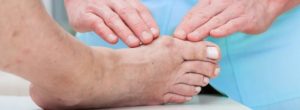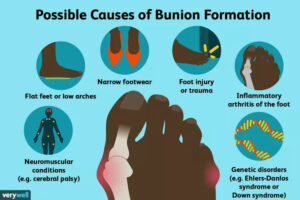Preventing Bunions
April 16 2023
Bunion problems are more common in older adults, especially women. Up to 33% of Americans have a bunion deformity. Dr. Malani discusses bunion symptoms, causes, prevention, and complications.
OVERVIEW:
- What are Bunions?
- Symptoms and Causes
- Complications
- Prevention
In recent years, bunions have become increasingly common worldwide. Nearly one-third of adults experience them, particularly individuals over 45.
This is why maintaining foot health is essential to a properly functioning and balanced skeletal system. Let’s explore how to prevent bunions, what causes them and what the symptoms are.
Bunions: What are they exactly?
Have you noticed a bony bump at the base of your big toe? Has is started to limit your mobility? In addition, has your big toe started to pull toward your other toes, forcing the base of your big toe to stick out? These are signs that you likely have a bunion.
Although bunion aren’t a life-threatening condition, they can become increasingly uncomfortable over time. If left untreated, bunions can cause several other painful ailments that severely limit your ability to walk and perform everyday tasks.
If you haven’t experienced a bunion but someone in your immediately family has, bunions may be in your future. Since your foot shape and structure is hereditary, bunions tend to run in the family. Although outside factors can contribute to this condition, it is imperative to learn how to prevent them before they form.
Bunions Prevention
Here are some measures to take for bunion prevention:
- Regularly stretch and strengthen your feet. Strength and flexibility is the key to success when it comes to your bodily health. Keeping your feet strong and limber will help minimize the risk of bunions developing.
- Remember to rest. We spend so much time on our feet, so it vital to give our feet a break whenever possible.
- Wear shoes that fit you properly. If your shoes are too loose or too tight, that can create tension or cause your feet to slide back and forth. This can put a lot of stress on the foot and contribute to bunions. When putting your foot in your shoe, you shouldn’t feel any pinching. Moreover, having to “break in” your shoes is a sign that they aren’t a good match. Also, adding arch support in your shoes (if there wasn’t any built-in) is helpful for your feet.
- Avoid wearing high heels. Although you may like how they look, nothing puts more pressure on your toes than wearing heels. Wearing flats is much more supportive of your feet. If you aren’t ready to give up your high heels, keeping the height under two inches will minimize potential pain and pressure.
- Be attentive to foot changes. If you notice pain or swelling, be sure to increase your self-care. If that doesn’t help, make an appointment with your podiatrist or go to urgent care.
Preventing Bunions: Know the Symptoms and Causes
Bunions can’t always be prevented. Unfortunately, there is a hereditary component to the condition. However, it is possible to keep the pain to a minimum by educating yourself.
Knowing the symptoms, causes, and possible complications can help you take care when bunions develop. This way, you can prevent further bunions from developing.
Symptoms:
- Swelling, redness, or soreness around your big toe joint
- The development of corns or calluses from your toes rubbing together
- Consistent pain or pain that comes and goes
- Limited mobility of your big toe
- A big bump on the outside of the base of your big toe
Causes:
- Flat feet or low arches
- Narrow footwear
- Stress or injuries
- Inflammatory arthritis of the foot
- Genetic disorders
Potential Additional Complications
If you have bunions and don’t take proper care, it is possible to develop other foot conditions as well. These complications include:
Bursitis: When the small pads that cushion the bones near your joints become inflamed
Hammertoe: An abnormal bend in the middle joint of a toe, causing pain and pressure
Metatarsalgia: Pain in the ball of your foot
 If you are suffering from a bunion, don’t delay. You can contact Dr. Malani’s office at (239) 430-3668 (FOOT) or visit NaplesPodiatrist.com to schedule an examination.
If you are suffering from a bunion, don’t delay. You can contact Dr. Malani’s office at (239) 430-3668 (FOOT) or visit NaplesPodiatrist.com to schedule an examination.
Dr. Karan Malani is a podiatric physician and surgeon practicing in Southwest Florida. Board Certified: American Board of Foot and Ankle Surgery.
—————–



 Fax: (239) 692-9436
Fax: (239) 692-9436 Tel: 239-430-3668
Tel: 239-430-3668

